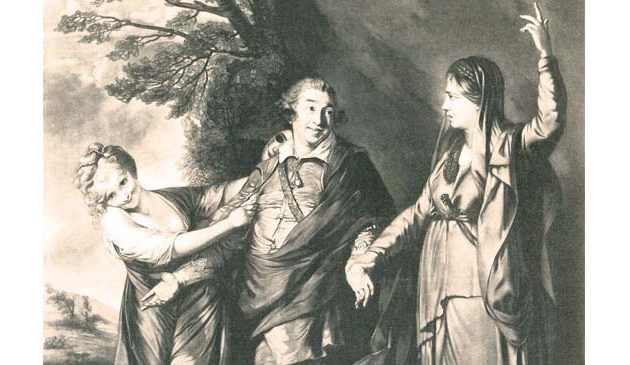Vauxhall Gardens and Jonathan Tyers

This is the scene confronting visitors as they arrived through the narrow hallway of the Proprietor’s House into Vauxhall Gardens. The Grand Walk stretches into the distance, a globe lamp hanging from each tree. On the right is the Grove, with the tall structure of the Orchestra, which was rebuilt in this style for the 1758 season. In the distance is a two dimensional tromp l’oeil wooden obelisk decorated by Francis Hayman. Part of the statue of Handel can be seen on the far right.
To anyone in 18th century Britain the name ‘Vauxhall’ meant the fashionable public garden. This was due to the vision of one man, working in partnership with some of the most talented musicians, artists, and designers of his generation. It played an important part in the flowering of the arts of Georgian London.
18th century London was a bustling, disorderly, and sometimes violent place, where most people worked hard to survive. The average home was unsuitable for entertaining, and the streets too inhospitable to linger. There were few entertainments within the city itself other than the theatres but the conurbation was still relatively small so the more pleasant countryside was within walking distance, or carriage ride. In the later decades of the 17th century pleasure gardens began to be established around the edge of the capital, where Londoners could spend the day or an evening socializing, eating, drinking, and being entertained in safety in a rural setting. One of the earliest, and most popular, was New Spring Gardens at Vauxhall. Under new management in the 18th century it was transformed into a venue that had a profound effect on London culture, providing patronage for London’s artists, designers, and musicians.
The New Spring Gardens opened in about 1661, shortly after the restoration of the monarchy. It was most easily reached by boat upriver along the Thames, about a 30-minute journey from the City. In its first 65 or more years it consisted of gravelled walks lined with bushes and trees and numerous ‘arbours’, or alcoves, in which couples or groups of visitors could hold private gatherings. These arbours were also popular for amorous encounters and over time the gardens became notorious for prostitution, thus acquiring a poor reputation.
We cannot be sure who first established the New Spring Gardens but by 1729 the proprietor was Elizabeth Masters on land leased from the Duchy of Cornwall. In that year Elizabeth sublet the gardens to the 27-year old Jonathan Tyers of Bermondsey. At the same time Tyers took a lease on the nearby original Spring Gardens to expand the size of the enterprise, together with its substantial house, which had been built in 1717.
The family business of Jonathan Tyers was in the leather trade and he accumulated some wealth while still young, probably selling some property to raise the finance to lease the two pleasure gardens.
They were situated a short distance from the river and reached by a lane. The front of Spring Gardens House faced westwards towards the river and its east-facing rear onto the gardens. The building was therefore adapted to become the entrance, ticket booth, and offices, and known as the Proprietor’s House. Tyers changed the gardens to an evening-only venue and most visitors arrived at around sunset.
From the start, Tyers was determined to change the reputation of the gardens by introducing cultural aspects, both for entertainment and education. In his own words, he wished to create “Diversion that may polish; without corrupting the Minds”. To improve the perception of the establishment he hired the poet and lyricist John Lockman to manage publicity and change the public image. Lockman often used the phrase “elegant Innocence” to describe the gardens. The continuous publicity he generated ensured that nobody in London, and very few around the country, would have not heard of, and did not want to visit, Vauxhall. Many plays and novels of the Georgian period included a scene or chapter set in the gardens.
In the next few years the gardens gradually began to be referred to as Vauxhall Gardens rather than the older name of New Spring Gardens. They were open three times a week between April or May and late August.
Prostitutes and pimps were henceforth refused entry, as were any who “in no way qualify’d to intermix with Persons of better Fashion”. Otherwise, all visitors who could afford the admission price, whatever their rank, were treated equally and charged the same entrance fee. To prevent distinction between different classes, servants were equally as welcome as their employers so long as they were not wearing uniform. Some criticised Tyers for allowing the indiscriminate mixing of classes, with footmen and parlour maids mixing with countesses and clergymen. On the other hand, Horace Walpole later wrote: “Admirable it was in a country of so much freedom…to see Princes & Peeresses mixed with tradesmen & their wives, wth apprentices & women of pleasure…”.
Despite Tyers’s apparent drive for respectability, a blind eye was largely turned towards less respectable behaviour, which took place in the unlit Druid’s Walk, also known as the Lover’s Walk, and the Dark Walks. Unsurprisingly, these featured in the journals of Giacomo Casanova when he visited London in 1763.
Tyers was highly successful in bringing a more respectable tone to the establishment but the crossing of boundaries between ranks, flirtation in the darker groves, and the party atmosphere on a summer’s night al fresco, were part of the charm that brought Londoners out to Vauxhall. That and the fun of arriving by boat and entering gardens, illuminated by 1,000 whale-oil lamps glimmering in the trees. A visitor in 1741 wrote that the lamp lighters “perform with so astonishing a rapidity, that in less than two minutes the whole garden appears as light as at noon day”.
The orchestra played from seven until nine, followed by a cold supper of chicken, beef, and notoriously thinly-sliced ham, cheesecakes and tarts, strawberries, sweet custard, washed down with port or sherry. One visitor marvelled at how “five hundred separate suppers are served in an instant”. Tyers himself kept a low profile, usually working behind the bar, and few visitors would have recognised him.


